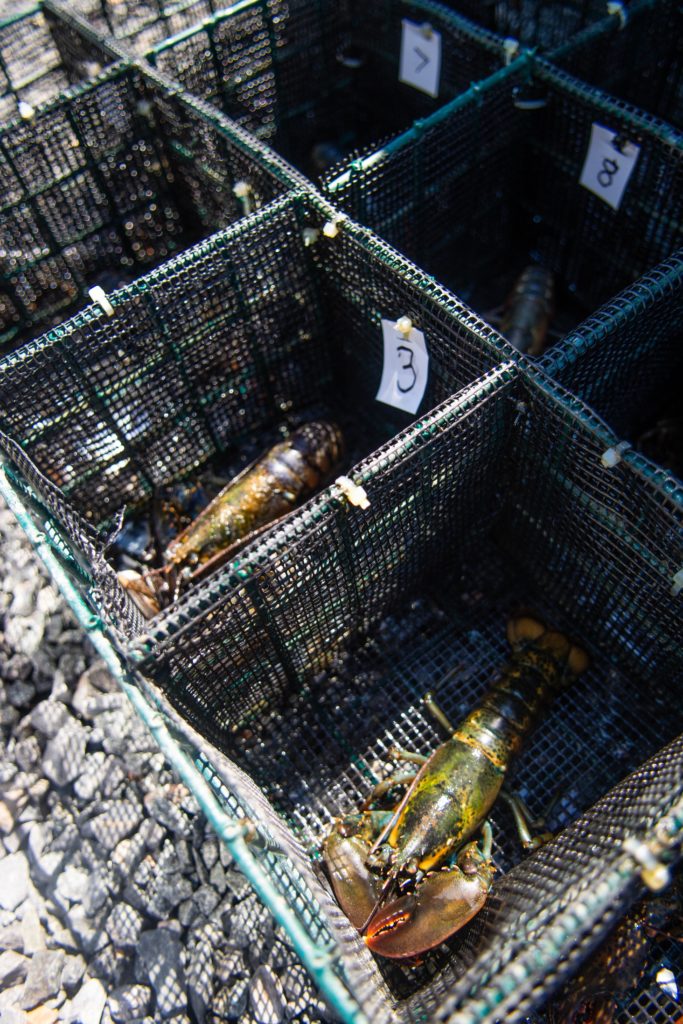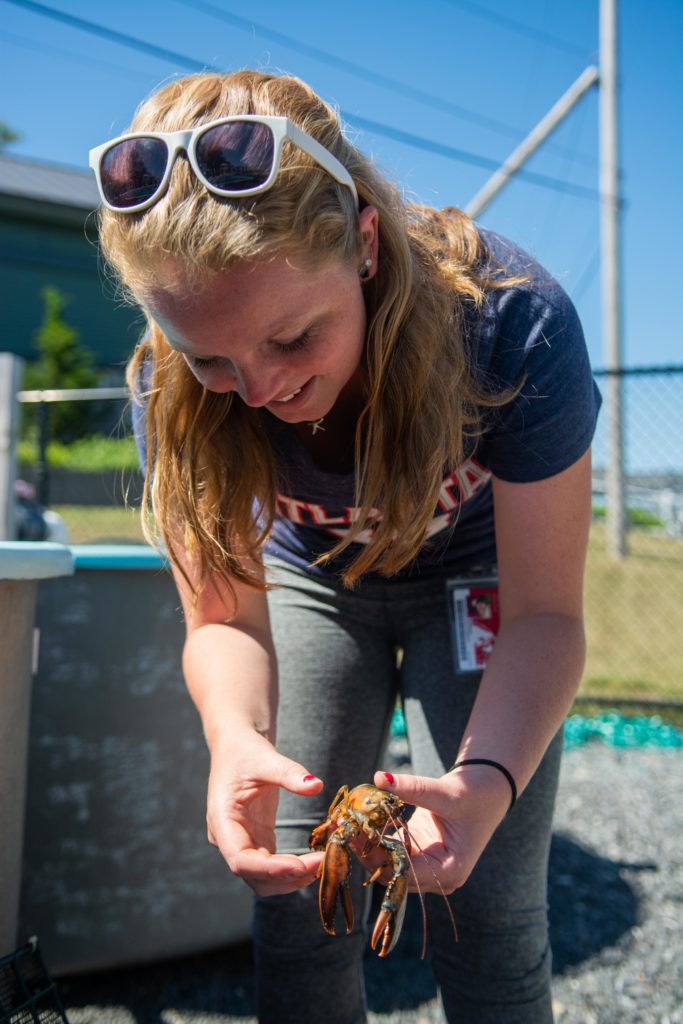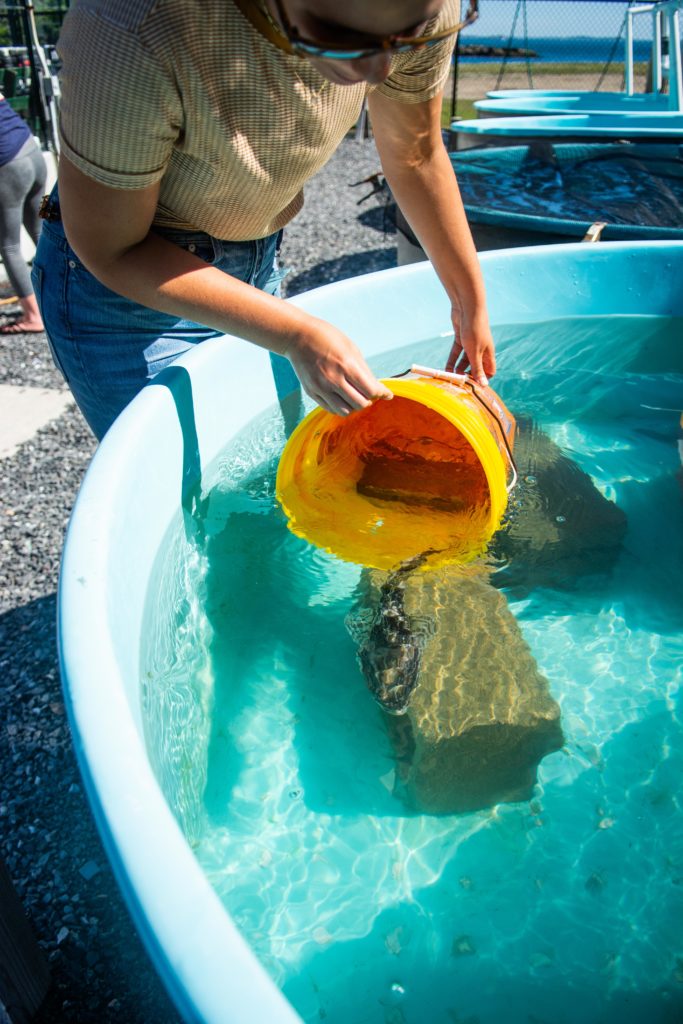Summer days in Nahant at Northeastern’s Marine Science Center can be hot, and Kelsey Schultz knows that better than most. Schultz spends many sweltering days under the sun at the tank farm, now running her second summer of experiments with Professors Jonathan Grabowski and Randall Hughes. She is currently the head lab technician for Grabowski’s lab, and will start graduate school with him in the fall.
The tank farm sits next to the greenhouse on the Marine Science Center’s campus, with a view of Boston’s skyline peeking over the horizon. Twenty, six-foot diameter tanks sit in rows of five, and these tanks house the Grabowski Lab’s experiments.
This summer, the tanks contain two things: lobsters and sculpin. The Grabowski lab is interested in competition in lobsters, especially when there’s a predator around. Lobsters compete for many things, including food, mates, and preferred habitat type. Lobsters prefer to hide out in rocky crevices where they are more protected from predators, rather than in seagrass, which affords some cover, and bare sand.

Lobsters are separated before the experiment to prevent fighting. Photo by Tim Briggs
The lobsters in the grassy habitat “still have some protection,” Schultz says, “but it’s the less preferred habitat.” Compared to in rocky habitats where lobsters can hide away under boulders, Schultz says “you can easily pluck out a lobster” from seagrass. However, they are the most at risk of being eaten in bare habitat.
Competition for these resources can be fierce. Schultz says “lobsters get injured when they compete for habitat. They lose their claws easily and often.” Losing a claw can be devastating. While lobsters have a relatively long lifespan—some species can live up to 50 years—it takes several months for a lost claw to regrow to full size. During those months they’re much more vulnerable to predation and survival becomes much more difficult.
As if a lobster with only one claw didn’t have enough on its plate, other lobsters don’t cut them any slack. In last summer’s experiments, Schultz and her colleagues found that “healthy lobsters roam around the tank and harass the injured lobsters. They’ll kick them out of seagrass, kick them out of rocky habitat.” This leaves an already vulnerable disarmed lobster out in the cold in its scariest habitat: open sand.
Without cover, lobsters are easy targets for predators like cod, sculpin, and striped bass. Recently, another predator has been introduced; the range of Black Sea Bass is expanding northward into the warming waters of the Gulf of Maine, which stretches from Cape Cod to Nova Scotia. Last summer, the researchers wanted to know what effect the presence of predators have on competition, using Black Sea Bass as the predator in their experiments.

A longhorn sculpin flexes its spiny fins after it was removed from its tank to be measured. Photo by Tim Briggs
The tanks were set up so that the researchers could see which habitat type lobsters preferred: rocky, seagrass, and bare areas. The lobsters could also ‘smell’ predators in the tank, in this case sculpin, through what are called chemical cues. By analyzing the choices of the lobsters, researchers can understand how the presence of a predator or competing lobster affects which habitats an injured lobster spends its time in.

Grabowski lab technician Adi Behrens labels small lobsters to help tell them apart during the experiment. Photo by Tim Briggs
This year, Schultz is trying sculpin as a predator. Sculpin are bottom fish that are found in many environments including the Gulf of Maine. Among other things, sculpin feed on small lobsters. Their specialized fins act as a defense and help them gain traction on the bottom of the ocean in high currents. The large spines on the fins and around the head of the fish give this species its name: Longhorn Sculpin. Measuring the length of a Longhorn is dangerous; Schultz dons thick gloves for protection from its formidable spines while she handles it. Schultz and the other researchers in the Grabowski lab hope to find out how lobsters react to sculpin, which have long been predators of lobsters in the Gulf of Maine.
Preliminary results show that one-clawed lobsters are at a huge disadvantage, and are easily bullied by the two-clawed competitors. “When a lobster that is already injured is in the bare habitat, it’s at a higher risk of being consumed, which is selecting for the more fit lobsters that can compete.” The results of this year’s experiment will help to fill in the gaps in our knowledge of how one-clawed lobsters fare in the ocean.
For now, Schultz is occupied with building and running this year’s experiment. “The setup has been the most challenging part. With our video cameras, they have to be around 9 feet over the tank to capture the whole tank. Figuring out how to get the camera that high, light the tank, and make sure you can actually see the lobsters has been difficult.”
Learn more about the Grabowski and Hughes labs at their lab websites.

Kelsey Schultz releases a sculpin back into a holding tank. Photo by Tim Briggs

